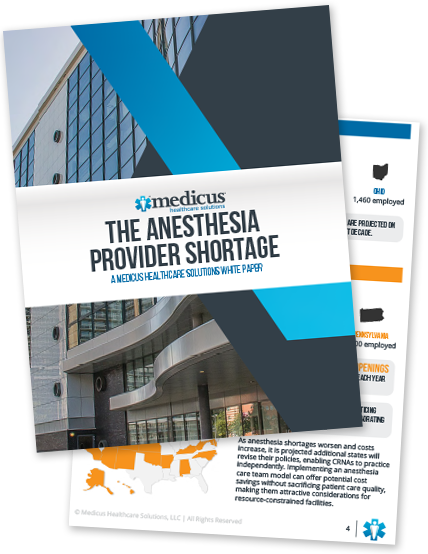The Anesthesia Provider Shortage: Confronting the Growing Demands for Care

As the demand for anesthesia services continues to grow, the gap between provider supply and clinical need presents a mounting challenge for both patient care and hospital operations. The Health Resources & Services Administration (HRSA) projects a shortage of 8,450 anesthesiologists by 2037. In parallel, the American Association of Nurse Anesthesiology (AANA) reports that 12% of CRNAs plan to retire by 2027.
Analyzing the Anesthesia Supply & Demand Imbalance
An Aging Population & Workforce
The need for anesthesiologists and CRNAs is accelerating, driven by an aging population and increased surgical utilization. According to data published in the Journal of Medicine, Surgery, and Public Health, surgical demand in the U.S. is projected to rise by 2–3% annually over the next decade, fueled in part by a 55% increase in the population aged 65 and older. By 2034, the proportion of surgical procedures involving older adults is expected to increase from 31% to 39%.
At the same time, the anesthesia workforce is aging. In 2020, the average age of anesthesiologists was 52.6 years, and 45% were over the age of 55. This suggests that a significant portion of the current workforce may retire or shift to part-time practice within the next decade. The CRNA workforce reflects a similar trend, with an average age of 47.5 years and growing concerns about long-term workforce sustainability. This combination of rising demand and a shrinking provider base heightens the risk of prolonged surgical wait times, delays in emergency care, and heavier workloads for existing staff.
Workforce Growth Limitations & Training Bottlenecks
Despite growing demand for anesthesia services, the pipeline for new providers remains constrained. In the 2025 Match, 1,805 PGY-1 anesthesiology residency positions were offered to more than 3,000 applicants, leaving over 1,200 unmatched. While this reflects roughly a 6.5% increase in available positions since 2024, the gap between the number of applicants and training capacity underscores a critical bottleneck in the anesthesiologist workforce.
CRNA education faces similar constraints. CRNA programs remain highly competitive with an average acceptance rate of 24%, with approximately 2,400 CRNAs graduating annually, according to the AANA. However, as of 2025, the requirement for all new CRNAs to hold a doctoral degree took effect, which could significantly impact the existing CRNA shortage by delaying workforce entry and deterring potential candidates from entering the field. Collectively, these constraints on anesthesiologist and CRNA training pathways limit workforce growth and continue to contribute to the ongoing anesthesia provider shortage.
Financial Implications of Limited Anesthesia Access
Operating Rooms (ORs) are one of the more challenging sectors within a health system to keep adequately staffed and optimally utilized. However, amid staffing challenges, healthcare leaders continue to face challenges in the recruitment and retention of surgeons, anesthesia providers, and OR staff. With surgical services often contributing up to 60% of a healthcare facility's revenue, and it taking an average of roughly 120 days to fill a permanent anesthesiologist position, even the temporary loss of a single anesthesiologist can disrupt case volumes, delay procedures, and jeopardize both revenue and continuity of care.
Solutions for Sustaining Anesthesia Coverage Amid Shortages
Healthcare leaders are deploying multiple strategies to address anesthesia staffing challenges. One widely used approach is leveraging locum tenens anesthesiologists and locum tenens CRNAs to manage fluctuations in patient volume, maintain continuity of care, and reduce workload pressure on permanent teams. Structured interim healthcare staffing models, such as the Medicus Transition Program, provide long-term, project-based solutions designed to stabilize clinical workforces and support consistent patient access.
Healthcare organizations are also expanding the use of anesthesia care team (ACT) models to improve efficiency and scalability. Unlike a physician-only model, which can be challenging to sustain amid ongoing anesthesiologist shortages, the ACT model integrates anesthesiologists, CRNAs, and anesthesiology assistants. This structure offers a cost-effective and adaptable solution to meet growing patient demand while maintaining high standards of care delivery.
Learn More about the Anesthesia Provider Shortage
Our white paper, "The Anesthesia Provider Shortage," provides healthcare leaders with an in-depth analysis of the current supply and demand imbalance, along with actionable strategies to sustain anesthesia services across various care settings.
To access the full report, complete the short form below.
The Anesthesia Provider Shortage

The Anesthesia Provider Shortage


